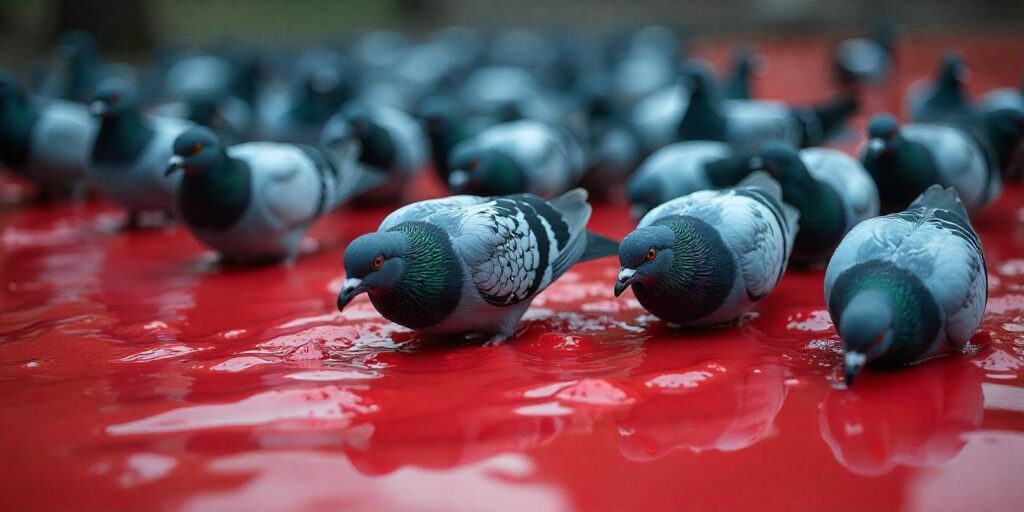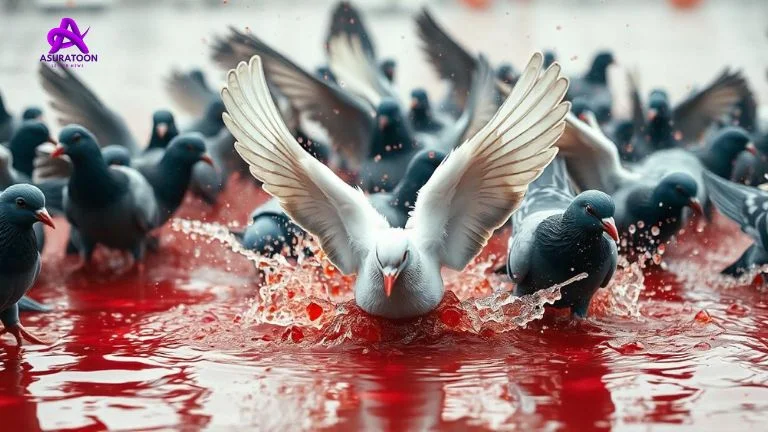Imagine a scene straight out of a quirky comedy: 275 pigeons diving headfirst into a pond—not just any pond, but one filled with bright red glue. This peculiar incident has captured the attention of social media and the curious minds of many. In this blog post, we’ll explore the details of this event, what happened, why it matters, and the reactions it sparked. So grab a snack, get comfy, and unravel this colorful tale together!
The Incident Unfolds
On a sunny afternoon in a local park, something extraordinary happened. In an unexpected twist, 275 pigeons made a daring leap into a pond mysteriously filled with bright red glue. While the visual of so many birds splashing into a sea of sticky substance is bizarre, it raises intriguing questions about the pigeons’ motivations and the circumstances surrounding this event.
What Led to the Dive?
Reports indicate that the pond was undergoing maintenance, and the red glue was part of a project for a nearby art installation. Unfortunately, the pigeons didn’t seem to get the memo! When they saw the shimmering surface, they took a collective plunge. It’s an amusing and slightly chaotic spectacle, highlighting how wildlife interacts with human environments.
Witness Accounts
Many park-goers witnessed this surreal event firsthand. One onlooker, Jenny, described it as “a scene out of a cartoon.” She recalled how the pigeons perched around the pond, seemingly deliberating before suddenly launching into the glue. Others reported laughing and filming the event, not quite believing their eyes.
How Did It All Happen?
The incident unfolded quickly. Initial reports suggested a nearby art project used red glue as a temporary installation medium. As park maintenance workers began preparing the area, the bright color attracted the attention of local wildlife, particularly the pigeons.
The Art Installation Context
The art installation was meant to reflect themes of community and unity. However, the unintentional consequence of attracting birds to the site turned a severe artistic endeavor into an unexpected wildlife spectacle. The park management had anticipated some animal curiosity but never expected such an overwhelming response from the pigeon population.
Why Red Glue?

You might wonder: What’s the deal with the red glue? While it’s not a common sight, the choice of color certainly added to the visual impact of the event. Here’s a deeper look at why this particular substance was used.
The Purpose of the Glue
- Artistic Expression: The glue was intended for an art installation to symbolize various themes like community and togetherness. The vibrant color was meant to draw attention and provoke thought. It was supposed to create a striking visual impact, and in that regard, it certainly succeeded—albeit unexpectedly.
- Temporary Structure: The glue was a temporary adhesive that was easy to clean up and a crucial aspect for the park’s maintainers. It was selected to minimize long-term impact on the environment. However, the presence of this colorful substance raised questions about the intersection of art and nature.
- Safety Considerations: While the glue was non-toxic, it wasn’t designed to accommodate wildlife. This brings us to the importance of considering the ecological impact of such projects. Ensuring that local fauna are not adversely affected should always be a priority in public spaces.
The Science Behind the Color
The choice of red wasn’t arbitrary. Color psychology suggests that red evokes strong emotions and captures attention. The idea was to spark interest and conversation. However, for the pigeons, it might have simply looked like a giant, inviting pool that promised adventure.
Pigeon Behavior: What’s Going On?
Pigeons are often misunderstood. They’re not just common city birds; they exhibit fascinating behaviors. Explain what motivated these 275 pigeons to dive into the glue-filled pond.
Curiosity and Exploration
Pigeons are naturally curious creatures. They explore their surroundings in search of food and safety. The bright red surface likely caught their eye, prompting the impulse to investigate. This highlights an essential aspect of animal behavior curiosity can sometimes lead to risky situations!
A Closer Look at Pigeon Intelligence
Pigeons are more intelligent than many people realize. Studies have shown that they can recognize themselves in mirrors, understand abstract concepts, and differentiate between artworks. Their curiosity and intelligence make them adept at navigating urban environments, but they can also get into precarious situations, as we saw in this incident.
Social Dynamics
Pigeons are social animals and tend to flock together. When one pigeon makes a move, others often follow. This could explain the sudden surge of 275 birds diving into the pond. It’s a classic case of “if my friend jumps in, I will too!”
Flocking Behavior
Flocking behavior is a survival mechanism that helps pigeons protect themselves from predators. In a situation like this, the combined action of many birds diving in might be rooted in their instinct to stick together, especially when faced with a new and intriguing environment.
Instincts at Play
Instinct plays a significant role in animal behavior. In the case of these pigeons, the dive might have been a blend of curiosity and a response to the environment. Birds often take risks, and in this instance, it resulted in an unusual yet captivating event.
The Environmental Impact
While the incident may seem humorous, it raises important questions about environmental responsibility. What happens when human activities intersect with wildlife habitats?
Short-Term Effects
- Immediate Chaos: The pigeons were initially trapped in the glue, causing a flurry of activity as they struggled to escape. Thankfully, park rangers quickly intervened, ensuring the birds were safe. Reports indicate that the rangers used warm water to help clean the pigeons and free them from the glue.
- Potential Harm: Even though the glue was non-toxic, being covered in a sticky substance can pose challenges for birds. Their feathers are essential for flight and insulation, and anything that disrupts their natural state can have consequences. It raises awareness about how even benign materials can be harmful in the wrong context.
Long-Term Considerations
- Wildlife Safety: This incident reminds us of the need for better planning in public spaces. Ensuring that art installations or maintenance work considers wildlife can prevent similar occurrences in the future. Creating clear barriers or signage could help deter animals from entering hazardous areas.
- Community Awareness: Events like this can raise awareness about the impact of human activities on wildlife. It’s a chance for communities to engage in discussions about how to coexist harmoniously with nature. Encouraging residents to be vigilant about the effects of their actions can foster a sense of stewardship for local ecosystems.
Best Practices for Environmental Stewardship
- Education: Promote community awareness about local wildlife and their habitats.
- Planning: Involve environmental specialists in planning public works or art installations to assess potential impacts.
- Monitoring: After completing projects, monitor the area to ensure wildlife is not adversely affected.
Social Media Reactions
As with any strange event, social media exploded with reactions. People shared videos, memes, and jokes about the incident, showcasing the internet’s love for quirky animal behavior.
Highlights from Social Media
- Humor and Creativity: Memes emerged, depicting the pigeons as bold adventurers diving into “the pool of opportunity.” The creative spin people put on the event made it a light-hearted topic amidst daily news. One meme showed a pigeon with sunglasses, captioned, “Living the dream!”—a perfect encapsulation of the humorous twist.
- Educational Moments: Some users took the opportunity to educate others about pigeon behavior and the importance of protecting wildlife from human-made hazards. Tweets and posts included links to resources about bird conservation and habitat protection, turning a light-hearted incident into a teachable moment.
- Calls for Action: Conservationists used the incident to advocate for better practices in urban planning and environmental awareness, pushing for a balance between art and nature. Discussions emerged about how art can harmonize with nature rather than disrupt it.
A Community Comes Together
The event united people in the park and online, sparking conversations about animal welfare and community responsibility. Local businesses even got involved, offering discounts on bird feeders and seeds to promote feeding and caring for local wildlife.
Lessons Learned
Every bizarre incident has lessons to offer. This event reminds us of the importance of being mindful of our surroundings, especially in shared environments. Here are a few takeaways:
- Respect for Wildlife: We must consider our projects’ impact on local wildlife. Simple precautions can go a long way in preventing unintended consequences. Creating marked zones, marked art, and maintenance zones will cause incidents in the future.
- Engagement with Nature: Encourage communities to engage with nature responsibly. Understanding animal behavior can lead to a greater appreciation for the wildlife around us. Hosting workshops or talks about local fauna can deepen this connection.
- Community Responsibility: Art projects should involve discussions about potential effects on local ecosystems, fostering a collaborative spirit between artists and environmentalists. Involving residents in the planning stages can provide valuable insights into the natural behaviors of wildlife in the area.
- Promoting Biodiversity: Encouraging biodiversity in public spaces enhances the ecosystem and provides habitat for various species. Projects can include native plantings that attract beneficial wildlife and create a balanced environment.
Conclusion
The event of 275 pigeons diving into a pond filled with red glue is more than just a whimsical tale; it reflects the complex relationship between humans and nature. As we continue to create and innovate, it’s vital to remember our responsibility towards the wildlife we share our spaces with.
By sharing this story, we celebrate nature’s quirky side and highlight meaningful discussions of environmental awareness and responsibility. So the next time you see a flock of pigeons, remember: they’re more than just birds—they’re part of our vibrant ecosystem, and it’s our job to keep it safe and enjoyable for everyone.
May You Like Also: Catherine The Great Furniture: A Glimpse into the Empress’s Opulent Lifestyle
